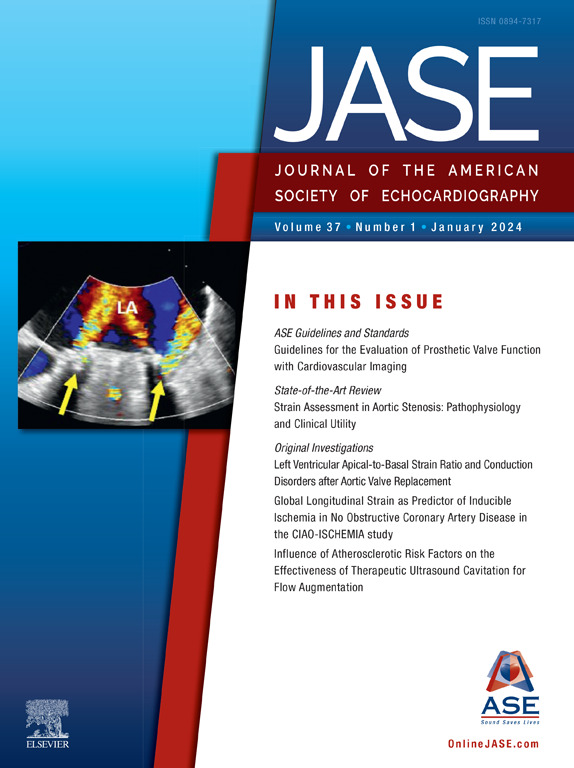心脏手术患者三维右心室射血分数与住院预后的关系多中心研究。
IF 6
2区 医学
Q1 CARDIAC & CARDIOVASCULAR SYSTEMS
Journal of the American Society of Echocardiography
Pub Date : 2025-08-01
DOI:10.1016/j.echo.2025.02.008
引用次数: 0
摘要
目的:心脏手术是治疗多种心脏病的基石,但准确的风险分层是至关重要的。常用的评分不包括右心室(RV)功能。我们的目的是评估3D右心室射血分数(RVEF)在调整EuroSCORE II后是否能预测心脏手术患者的预后。方法和结果:对3个中心接受心脏手术的成人患者进行前瞻性多中心研究。术前经食管超声心动图分析右心室功能参数。在调整EuroSCORE II后,我们评估了3D RVEF与主要结局(院内死亡率或临时心室辅助装置需求的复合)的关系。探索性终点为机械通气时间和收缩力时间。我们纳入248例患者(中位年龄69岁;43%的女性)。69% RVEF正常(≥45%)。RVEF降低组右心室功能参数(TAPSE、FAC和RVFWLS)较低(结论:在右心室功能参数中,3D RVEF是心脏手术患者住院死亡率或需要临时心室辅助装置的最强预测因子。这项多中心研究表明,3D RVEF应纳入手术患者的评估,因为它可能改善分层。本文章由计算机程序翻译,如有差异,请以英文原文为准。
Association Between Three-Dimensional Right Ventricular Ejection Fraction and In-Hospital Outcomes in Patients Undergoing Cardiac Surgery: A Multicenter Study
Aims
Cardiac surgery is the cornerstone of treatment of several heart conditions, but accurate risk stratification is critical. Commonly used scores do not include right ventricular (RV) function. We aimed to evaluate whether three-dimensional (3D) RV ejection fraction (RVEF) predicts outcomes in patients undergoing cardiac surgery after adjusting for the EuroSCORE II.
Methods and results
This is a prospective multicenter study of adult patients undergoing cardiac surgery at 3 centers. Right ventricular function parameters were analyzed with transesophageal echocardiogram before the surgery. We evaluated the association of 3D RVEF with the primary outcome (composite of in-hospital mortality or need of temporary ventricular assist device) after adjusting for the EuroSCORE II. Exploratory end points were time on mechanical ventilation and time on inotropes. We included 248 patients (median age, 69 years; 43% female). Sixty-nine percent had normal RVEF (≥45%). Right ventricular function parameters (tricuspid annular plane systolic excursion, fractional area change, and RV free-wall longitudinal strain) were lower in the group of decreased RVEF (P < .001 for all). The primary outcome occurred in 28 patients (11%). After adjusting for the EuroSCORE II, decreased RVEF was independently associated with the primary outcome (hazard ratio = 2.46; 95% CI, 1.10, 5.50; P = .028). Importantly, 3D RVEF was superior to all other parameters of RV systolic function to predict the primary outcome (P = .006). At 30 days, survival free of the primary end point was 72% ± 8% versus 93% ± 3% (P < .001) in decreased versus normal RVEF, respectively. Right ventricular ejection fraction was associated with shorter time on mechanical ventilation (r = −0.27, P < .001) and shorter time on inotropes (r = −0.20, P = .01).
Conclusions
Among the RV function parameters, 3D RVEF is the strongest predictor of in-hospital mortality or need of temporary ventricular assist device in patients undergoing cardiac surgery. This multicenter study suggests that 3D RVEF should be included in the evaluation of patients undergoing surgery because it might improve stratification.
求助全文
通过发布文献求助,成功后即可免费获取论文全文。
去求助
来源期刊
CiteScore
9.50
自引率
12.30%
发文量
257
审稿时长
66 days
期刊介绍:
The Journal of the American Society of Echocardiography(JASE) brings physicians and sonographers peer-reviewed original investigations and state-of-the-art review articles that cover conventional clinical applications of cardiovascular ultrasound, as well as newer techniques with emerging clinical applications. These include three-dimensional echocardiography, strain and strain rate methods for evaluating cardiac mechanics and interventional applications.

 求助内容:
求助内容: 应助结果提醒方式:
应助结果提醒方式:


